An Integrated Approach for Modeling Wetland Water Level: Application to a Headwater Wetland in Coastal Alabama, USA
Abstract
1. Introduction
2. Study Area and Data Sets
3. Methodology
3.1. Soil and Water Assessment Tool (SWAT)
3.2. Artificial Neural Networks (ANNs)
3.3. SWAT-ANN Coupling
3.4. El Niño Southern Oscillation (ENSO) Effects on WL Variations
4. Results
4.1. SWAT-ANN Model Performance
4.2. Teleconnection between ENSO and WLs
5. Discussion
6. Summary and Conclusions
- Coupled SWAT-ANN model was proved to be a viable tool to simulate WLs for wetlands at a daily time scale. By examining the ratio of the number of training samples to the number of connection weights, the model development was conducted cautiously to avoid the overfitting problem that is commonly ignored in the application of machine learning techniques in the hydrology and water resources field. Note that there are more sophisticated techniques to avoid overfitting, such as adding regularization to the cost function, and dropout regularization [58], but those have not been considered in this study.
- Correlations between the Niño index representing various ENSO phases and seasonal precipitations were non-significant at the study wetland, except for a positive correlation in winter during the El Niño phase. Correlations between the Niño index and seasonal WLs were non-significant, except for spring during the El Niño phase, which had a negative correlation. Hence, the findings suggest that winter gets wetter with regards to precipitation and spring gets drier in terms of WL over the El Niño phase in the study area.
- The teleconnection between WLs and ENSO phases shown in this study can also have important implications for the wetland vegetation and the functioning of wetlands. Specifically, in our study wetland, a reduction in WLs are expected in spring during El Niño and this would potentially lead to reduced organic material and carbon stock and the same impacts could be expected in the other headwater wetlands of Baldwin County, Alabama.
Author Contributions
Funding
Acknowledgments
Conflicts of Interest
References
- Savage, R.; Baker, V. The Importance of Headwater Wetlands and Water Quality in North Carolina. 2007. Available online: http://water.epa.gov/type/wetlands/assessment/survey/presentations.cfm (accessed on 10 January 2015).
- Noble, C.V.; Wakeley, J.S.; Roberts, T.H.; Henderson, C. Regional Guidebook for Applying the Hydrogeomorphic Approach to Assessing the Functions of Headwater Slope Wetlands on the Mississippi and Alabama Coastal Plains; U.S. Army Corps of Engineers: Washington, DC, USA, 2007.
- Rezaeianzadeh, M.; Kalin, L.; Anderson, C. Wetland Water-Level Prediction Using ANN in Conjunction with Base-Flow Recession Analysis. J. Hydrol. Eng. 2015, 22, D4015003. [Google Scholar] [CrossRef]
- Mitsch, W.J.; Gosselink, J.G. Wetlands, E-book. 2015. Available online: http://auburn.eblib.com/patron/FullRecord.aspx?p=1895927 (accessed on 16 November 2015).
- Ouyang, X.; Lee, S.Y. Updated estimates of carbon accumulation rates in coastal marsh sediments. Biogeosciences 2014, 11, 5057–5071. [Google Scholar] [CrossRef]
- Kang, H.; Jang, I.; Kim, S. Key processes in CH4 dynamics in wetlands and possible shifts with climate change. In Global Change and the Function and Distribution of Wetlands; Middleton, B.A., Ed.; Springer: New York, NY, USA, 2012; pp. 99–114. [Google Scholar]
- Ouyang, X.; Lee, S.Y.; Connolly, R.M. Structural equation modelling reveals factors regulating surface sediment organic carbon content and CO2 efflux in a subtropical mangrove. Sci. Total Environ. 2017, 578, 513–522. [Google Scholar] [CrossRef] [PubMed]
- Daulat, W.E.; Clymo, R.S. Effects of temperature and watertable on the efflux of methane from peatland surface cores. Atmos. Environ. 1998, 32, 3207–3218. [Google Scholar] [CrossRef]
- Chimner, R.A.; Cooper, D.J. Influence of water table levels on CO2 emissions in a Colorado subalpine fen: An in situ microcosm study. Soil Biol. Biochem. 2003, 35, 345–351. [Google Scholar] [CrossRef]
- McVoy, C.W.; Said, W.P.; Obeysekera, J.; Van Arman, J.A.; Dreschel, T.W. Landscapes and Hydrology of the Predrainage Everglades; University Press of Florida: Gainesville, FL, USA, 2011. [Google Scholar]
- Van der Valk, A.; Volin, J.; Wetzel, P. Predicted changes in interannual water-level fluctuations due to climate change and its implications for the vegetation of the Florida Everglades. Environ. Manag. 2015, 55, 799–806. [Google Scholar] [CrossRef] [PubMed]
- Hodson, E.L.; Poulter, B.; Zimmermann, N.E.; Prigent, C.; Kaplan, J.O. The El Niño-Southern Oscillation and wetland methane interannual variability. Geophys. Res. Lett. 2011, 38, L08810. [Google Scholar] [CrossRef]
- Singh, S.; Srivastava, P.; Abebe, A.; Mitra, S. Baseflow response to climate variability induced droughts in the Apalachicola–Chattahoochee–Flint River Basin, U.S.A. J. Hydrol. 2015, 528, 550–561. [Google Scholar] [CrossRef]
- Ouyang, X.; Lee, S.Y.; Connolly, R.M.; Kainz, M.J. Spatially-explicit valuation of coastal wetlands for cyclone mitigation in Australia and China. Sci. Rep. 2018, 8, 3035. [Google Scholar] [CrossRef] [PubMed]
- Dall’O, M.; Kluge, W.; Bartels, F. FEUWAnet: A multi-box water level and lateral exchange model for riparian wetlands. J. Hydrol. 2001, 250, 40–62. [Google Scholar] [CrossRef]
- Spieksma, J.F.M.; Schouwenaars, J.M. A simple procedure to model water level fluctuations in partially inundated wetlands. J. Hydrol. 1997, 196, 324–335. [Google Scholar] [CrossRef]
- House, A.R.; Thompson, J.R.; Acreman, M.C. Projecting impacts of climate change on hydrological conditions and biotic responses in a chalk valley riparian wetland. J. Hydrol. 2016, 534, 178–192. [Google Scholar] [CrossRef]
- Dadaser-Celik, F.; Cengiz, E. A neural network model for simulation of water levels at the Sultan Marshes wetland in Turkey. Wetlands Ecol. Manag. 2013, 21, 297–306. [Google Scholar] [CrossRef]
- Barksdale, W.F.; Anderson, C.J.; Kalin, L. The influence of watershed run-off on the hydrology, forest floor litter and soil carbon of headwater wetlands. Ecohydrology 2014, 7, 803–814. [Google Scholar] [CrossRef]
- Barksdale, W.F. The Effect of Land Use/Land Cover on Headwater-Slope Wetlands in Baldwin County, Alabama. Master’s Thesis, Auburn University, Auburn, AL, USA, 2013. [Google Scholar]
- Barksdale, W.F.; Anderson, C.J. The influence of land use on forest structure, species composition, and soil conditions in headwater-slope wetlands of coastal Alabama, USA. Int. J. Biodivers. Sci. Ecosyst. Serv. Manag. 2014. [Google Scholar] [CrossRef]
- Nilsson, K.A.; Rains, M.C.; Lewis, D.B.; Trout, K.E. Hydrologic characterization of 56 geographically isolated wetlands in west-central Florida using a probabilistic method. Wetlands Ecol. Manag. 2013, 21, 1–14. [Google Scholar] [CrossRef]
- Loukas, A.; Vasiliades, L. Streamflow simulation methods for ungauged and poorly gauged watersheds. Nat. Hazards Earth Syst. Sci. 2014, 14, 1641–1661. [Google Scholar] [CrossRef]
- Noori, N.; Kalin, L. Coupling SWAT and ANN Models for Enhanced Daily Streamflow Prediction. J. Hydrol. 2016, 533, 141–151. [Google Scholar] [CrossRef]
- Mekonnen, A.; Nazemi, A.; Mazurek, K.A.; Elshorbagy, A.; Putz, G. Hybrid modelling approach to prairie hydrology: Fusing data-driven and process-based hydrological models. Hydrol. Sci. J. 2015, 60, 1473–1489. [Google Scholar] [CrossRef]
- McBride, E.H.; Burgess, L.H. Soil survey of Baldwin County, Alabama. U.S. Department of Agriculture. Soil Conservation Service. Soil Surv. Rep. 1964, 12, 110. [Google Scholar]
- USDA Web Soil Survey. Available online: https://websoilsurvey.nrcs.usda.gov (accessed on 9 January 2018).
- National Climatic Data Center. Available online: http://www.ncdc.noaa.gov/statistical-weather-and-climate-information (accessed on 15 December 2012).
- Arnold, J.G.; Srinivasan, R.; Muttiah, R.S.; Williams, J.R. Large area hydrologic modeling and assessment: Part I. Model development. J. Am. Water Resour. Assoc. 1998, 34, 73–89. [Google Scholar] [CrossRef]
- Neitsch, S.L.; Arnold, J.G.; Kiniry, J.R.; Williams, J.R. Soil and water assessment tool: Theoretical documentation, version 2009. In Grassland, Soil and Water Research Laboratory-Agricultural Research Service; Blackland Research Center, Texas AgriLife Research: Temple, TX, USA, 2011; 647p. [Google Scholar]
- Soil Survey Geographic Database (SSURGO). Available online: https://www.nrcs.usda.gov/wps/portal/nrcs/detail/soils/survey/?cid=nrcs142p2_053627 (accessed on 9 January 2018).
- National Land Cover Database (NLCD). Available online: https://www.mrlc.gov/nlcd2011.php (accessed on 9 January 2018).
- Lu, J.; Sun, G.; Amatya, D.M.; McNulty, S.G. A Comparison of six potential evapotranspiration methods for regional use in the southeastern United States. J. Am. Water Resour. Assoc. 2005, 41, 621–633. [Google Scholar] [CrossRef]
- Hamon, W.R. Estimating potential evapotranspiration. J. Hydraul. Div. Proc. Am. Soc. Civ. Eng. 1961, 871, 107–120. [Google Scholar]
- Vogl, T.P.; Mangis, J.K.; Rigler, A.K.; Zink, W.T.; Alkon, D.L. Accelerating the convergence of the backpropagation method. Biol. Cybern. 1998, 59, 256–264. [Google Scholar]
- Rezaeian Zadeh, M.; Amin, S.; Khalili, D.; Singh, V.P. Daily outflow prediction by multilayer perceptron with logistic sigmoid and tangent sigmoid activation functions. Water Resour. Manag. 2010, 24, 2673–2688. [Google Scholar] [CrossRef]
- MathWork, Inc. Matlab User’s Manual, version 7.1.1.; The MathWorks, Inc.: Natick, MA, USA, 2010. [Google Scholar]
- Maier, H.R.; Dandy, G.C. Neural networks for the prediction and forecasting of water resource variables: A review of modelling issues and applications. Environ. Model. Softw. 2000, 15, 101–124. [Google Scholar] [CrossRef]
- Kaastra, I.; Boyd, M.S. Forecasting futures trading volume using neural networks. J. Futures Mark. 1995, 15, 953–970. [Google Scholar] [CrossRef]
- Karunanithi, N.; Grenney, W.J.; Whitley, D.; Bovee, K. Neural networks for river flow prediction. J. Comput. Civ. Eng. 1994, 8, 201–220. [Google Scholar] [CrossRef]
- Cigizoglu, H.K. Estimation, forecasting and extrapolation of river flows by artificial neural networks. Hydrol. Sci. J. 2003, 48, 349–361. [Google Scholar] [CrossRef]
- Rezaeian-Zadeh, M.; Zand-Parsa, S.; Abghari, H.; Zolghadr, M.; Singh, V.P. Hourly air temperature driven using multi-layer perceptron and radial basis function networks in arid and semi-arid regions. Theor. Appl. Climatol. 2012, 109, 519–528. [Google Scholar] [CrossRef]
- Hosseinzadeh Talaee, P.; Tabari, H.; Sobhan Ardakani, S. Hydrological drought in the west of Iran and possible association with large-scale atmospheric circulation patterns. Hydrol. Process. 2014, 28, 764–773. [Google Scholar] [CrossRef]
- Cheng, B.; Titterington, D.M. Neural networks: A review from a statistical perspective. Stat. Sci. 1994, 9, 2–54. [Google Scholar] [CrossRef]
- Weigend, T. Practical Neural Network Recipes in C++; Academic Press: San Diego, CA, USA, 1993. [Google Scholar]
- Weigend, A.S.; Rumelhart, D.E.; Huberman, B.A. Predicting the future: A connectionist approach. Int. J. Neural Syst. 1990, 1, 193–209. [Google Scholar] [CrossRef]
- Amari, S.-I.; Murata, N.; Muller, K.-R.; Finke, M.; Yang, H.H. Asymptotic statistical theory of overtraining and cross-validation. IEEE Trans. Neural Netw. 1997, 8, 985–996. [Google Scholar] [CrossRef] [PubMed]
- Sethi, R.R.; Kumar, A.; Sharma, S.P.; Verma, H.C. Prediction of water table depth in a hard rock basin by using artificial neural network. Int. J. Water Resour. Environ. Eng. 2010, 2, 95–102. [Google Scholar]
- Adamowski, J.; Prasher, S. Comparison of machine learning methods for runoff forecasting in mountaineous watersheds with limited data. J. Water Land Dev. 2012, 17, 89–97. [Google Scholar] [CrossRef]
- Sharda, V.; Srivastava, P.; Ingram, K.; Chelliah, M.; Kalin, L. Quantification of El Niño Southern Oscillation (ENSO) impact on precipitation and stream flows for improved management of water resources in Alabama. J. Soil Water Conserv. 2012, 67, 158–172. [Google Scholar] [CrossRef]
- Mo, K.C.; Schemm, J.E. Relationship between ENSO and drought over the Southeastern United States. Geophys. Res. Lett. 2008, 35, L15701. [Google Scholar] [CrossRef]
- Lee, S.-K.; Mapes, B.E.; Wang, C.; Enfield, D.B.; Weaver, S.J. Springtime ENSO phase evolution and its relation to rainfall in the continental U.S. Geophys. Res. Lett. 2014, 41, 1673–1680. [Google Scholar] [CrossRef]
- Mearns, L.O.; Giorgi, F.; Shields, C.; McDaniel, L. Climate scenarios for the southeastern US based on GCM and regional modeling simulations. Clim. Chang. 2003, 60, 7–36. [Google Scholar] [CrossRef]
- Majidzadeh, H.; Wang, J.; Chow, A.T. Prescribed Fire Alters Dissolved Organic Matter and Disinfection By-Product Precursors in Forested Watersheds—Part I. A Controlled Laboratory Study. In Recent Advances in Disinfection By-Products; American Chemical Society: Washington, DC, USA, 2015; Chapter 15; pp. 271–292. [Google Scholar]
- Todd, M.J.; Muneepeerakul, R.; Miralles-Wilhelm, F.; Rinaldo, A.; Rodriguez-Iturbe, I. Possible climate change impacts on the hydrological and vegetative character of Everglades National Park, Florida. Ecohydrology 2012, 5, 326–336. [Google Scholar] [CrossRef]
- Zhu, Q.; Peng, C.; Ciais, P.; Jiang, H.; Liu, J.; Bousquet, P.; Li, S.; Chang, J.; Fang, X.; Zhou, X.; et al. Interannual variation in methane emissions from tropicalwetlands triggered by repeated El Ni~no Southern Oscillation. Glob. Chang. Biol. 2017, 23, 4706–4716. [Google Scholar] [CrossRef] [PubMed]
- Erwin, K.L. Wetlands and global climate change: The role of wetland restoration in a changing world. Wetlands Ecol. Manag. 2009, 17, 71–84. [Google Scholar] [CrossRef]
- Srivastava, N.; Hinton, G.; Krizhevsky, A.; Sutskever, I.; Salakhutdinov, R. Dropout: A simple way to prevent neural networks from overfitting. J. Mach. Learn. Res. 2014, 15, 1929–1958. [Google Scholar]
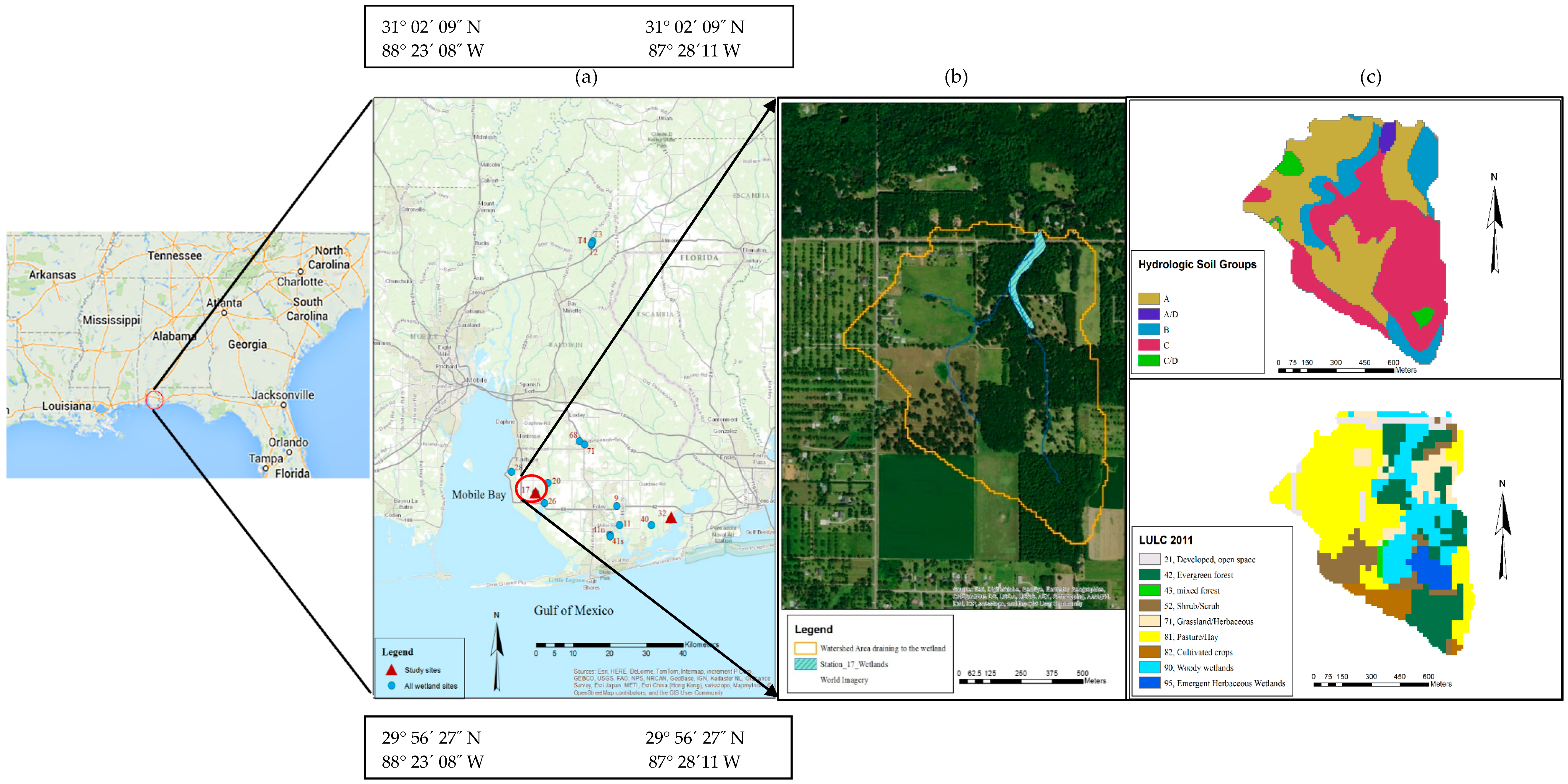
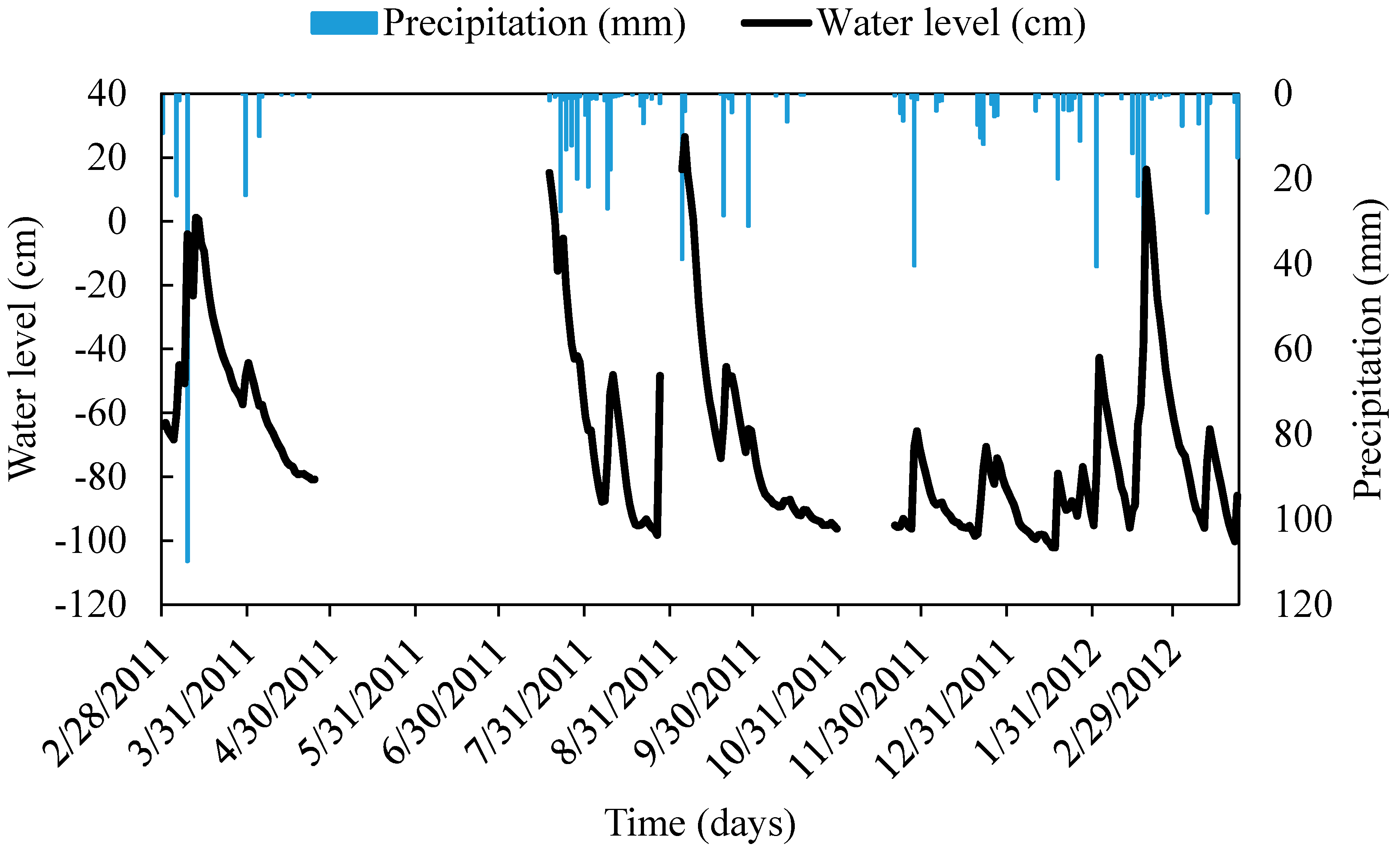
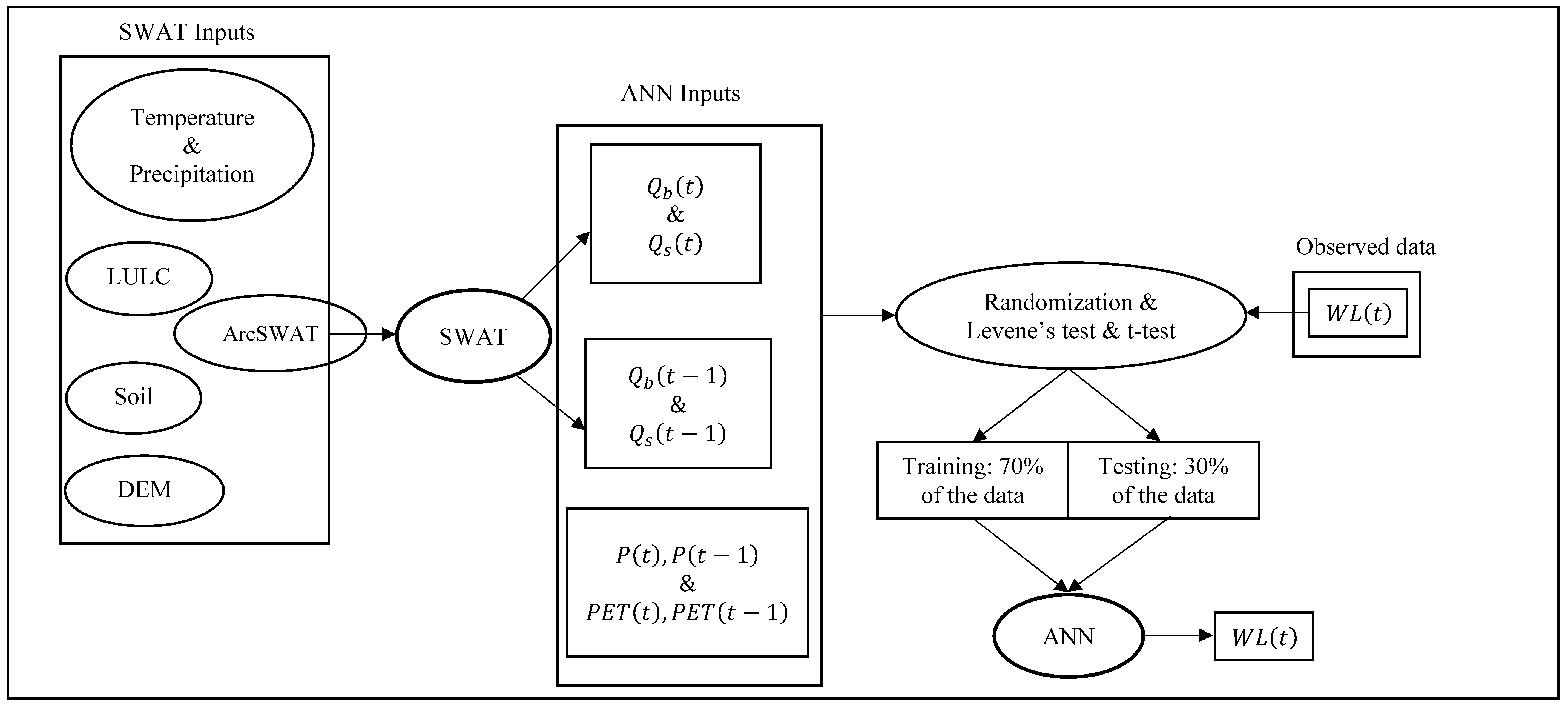
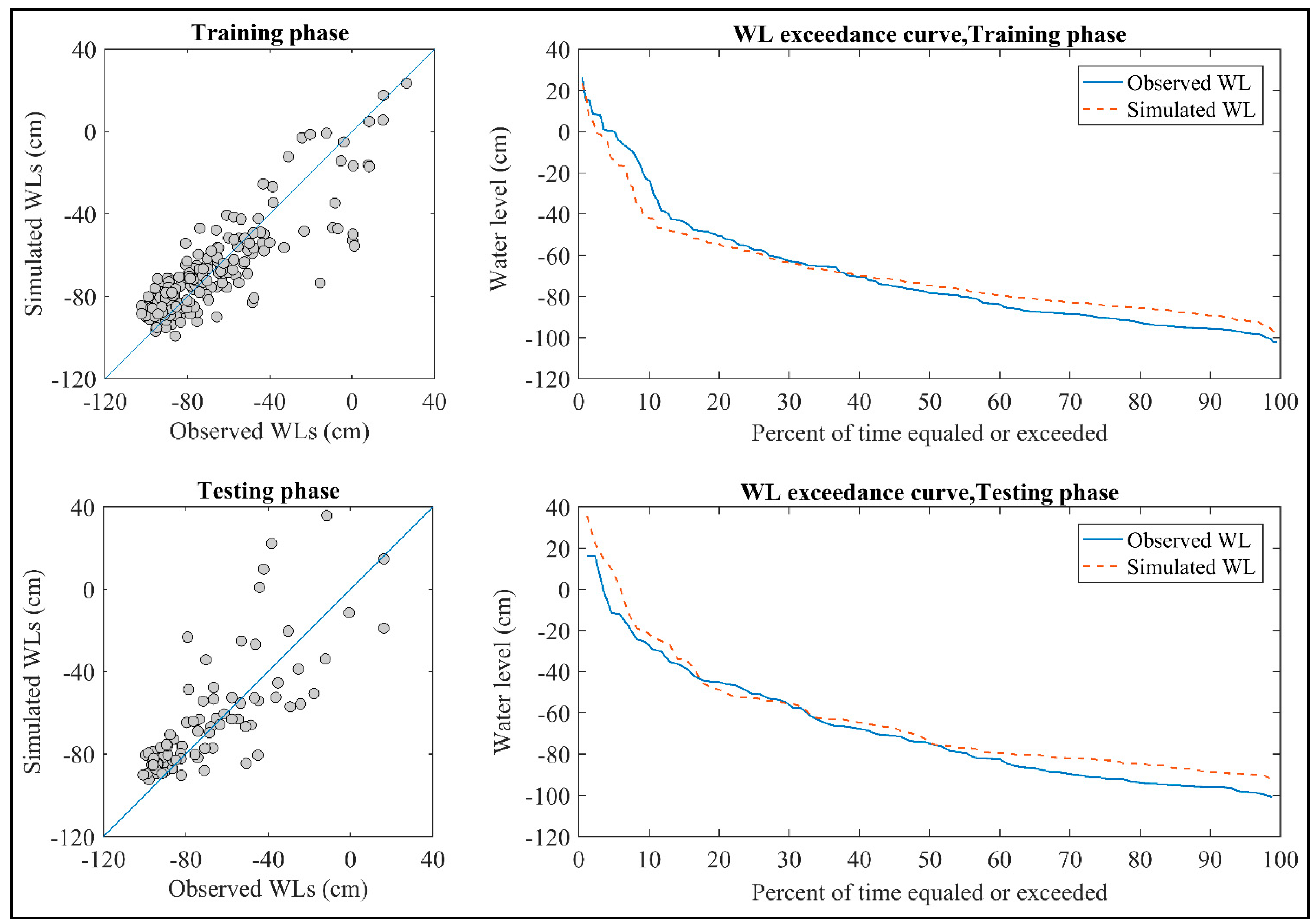

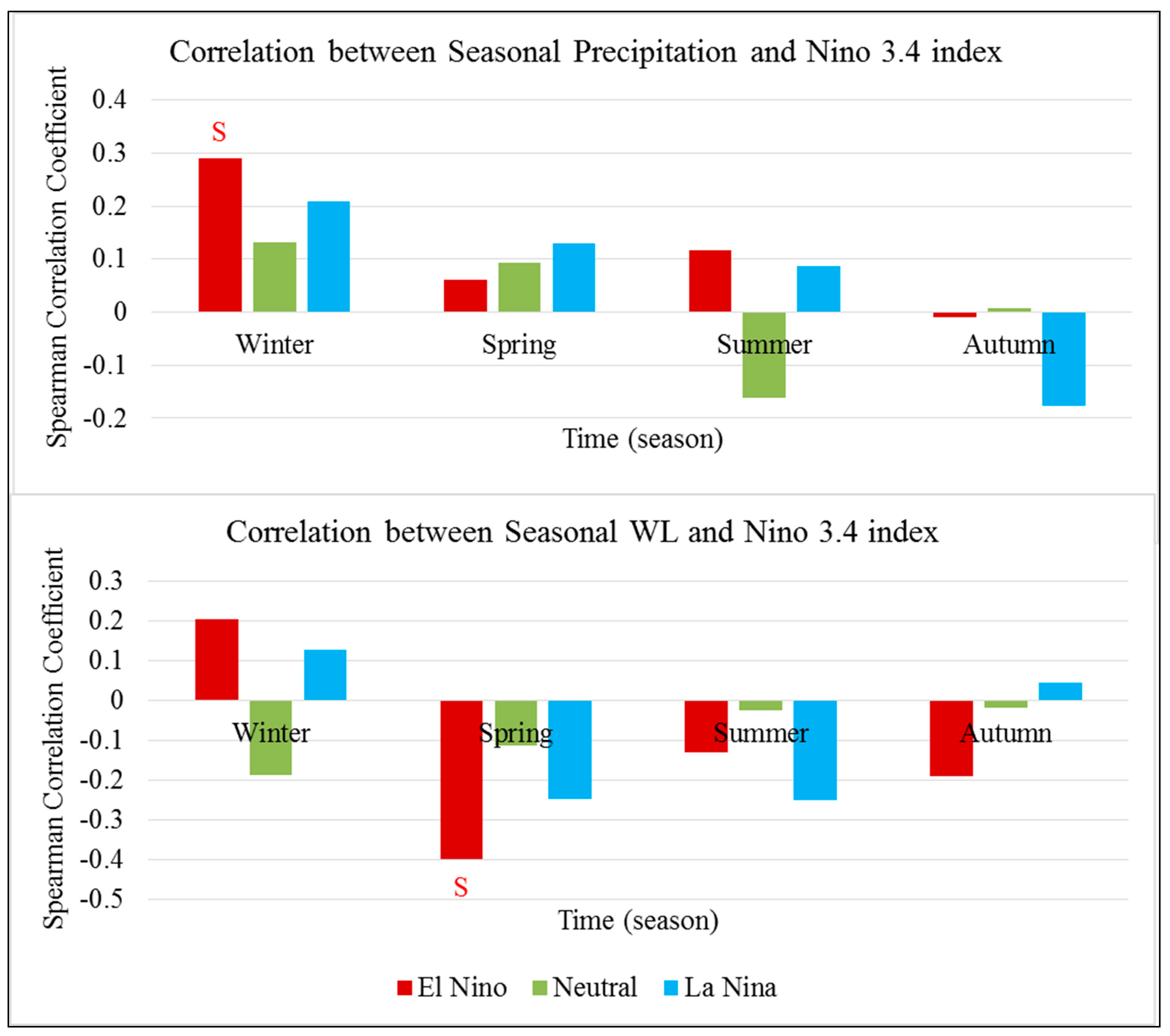
© 2018 by the authors. Licensee MDPI, Basel, Switzerland. This article is an open access article distributed under the terms and conditions of the Creative Commons Attribution (CC BY) license (http://creativecommons.org/licenses/by/4.0/).
Share and Cite
Rezaeianzadeh, M.; Kalin, L.; Hantush, M.M. An Integrated Approach for Modeling Wetland Water Level: Application to a Headwater Wetland in Coastal Alabama, USA. Water 2018, 10, 879. https://doi.org/10.3390/w10070879
Rezaeianzadeh M, Kalin L, Hantush MM. An Integrated Approach for Modeling Wetland Water Level: Application to a Headwater Wetland in Coastal Alabama, USA. Water. 2018; 10(7):879. https://doi.org/10.3390/w10070879
Chicago/Turabian StyleRezaeianzadeh, Mehdi, Latif Kalin, and Mohamed M. Hantush. 2018. "An Integrated Approach for Modeling Wetland Water Level: Application to a Headwater Wetland in Coastal Alabama, USA" Water 10, no. 7: 879. https://doi.org/10.3390/w10070879
APA StyleRezaeianzadeh, M., Kalin, L., & Hantush, M. M. (2018). An Integrated Approach for Modeling Wetland Water Level: Application to a Headwater Wetland in Coastal Alabama, USA. Water, 10(7), 879. https://doi.org/10.3390/w10070879





